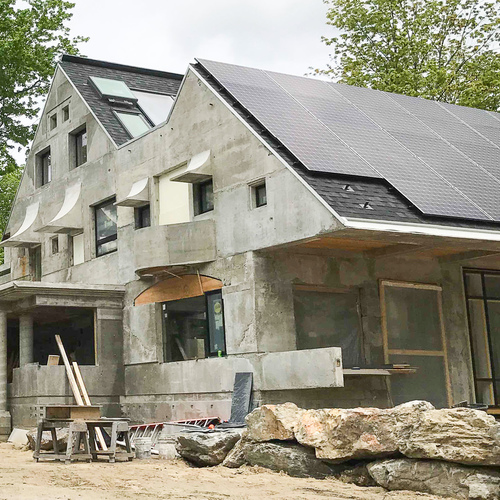
Almost all branches of American art and culture, including music and architecture, experienced a remarkable explosion of creativity from 1965 to 1975. While I can’t explain the causes of these cultural revolutions — I’ll leave that task to sociologists and historians — I’ll briefly mention what happened during those years: LSD, hippies, free love, second-wave feminism, draft resistance, the Stonewall riots, and the back-to-the land movement. And that’s just for starters.
Historians of architecture have looked back on those years as the origin of the design-build movement, and they are remarkably specific about the movement’s point of origin. The physical location is Prickly Mountain in Warren, Vermont; the years are 1965 to 1970; and the catalyst was a Yale architect named David Sellers, along with a group of like-minded Ivy League architects who clustered around him, including Steve Badanes, John Connell, Louis Mackall, Bill Maclay, Jim Sanford, Barry Simpson, and Dick Travers.
The story of Prickly Mountain is an example of how residents of the tiny state of Vermont have played an outsized role in an important architectural movement.
The back-to-the-land invasion
In recent years, as the back-to-the land generation retires, Vermont historians have begun to pay attention to the profound changes wrought by the tens of thousands of back-to-the-landers who invaded the state in the late 1960s and early 1970s. We arrived poor, and were more likely to apply for food stamps than to apply for a 9-to-5 job. But by the 1980s and 1990s, many members of our generation had trimmed our hair, completed our educations, and become pillars of our communities. We turned into teachers, social workers, nurses, and elected officials. And, for better or worse, we ended up changing the state.
Most of the urban refugees who imitated the Prickly Mountain architects — young people who moved…
Weekly Newsletter
Get building science and energy efficiency advice, plus special offers, in your inbox.

This article is only available to GBA Prime Members
Sign up for a free trial and get instant access to this article as well as GBA’s complete library of premium articles and construction details.
Start Free TrialAlready a member? Log in













9 Comments
Great article Martin. That explains a lot about how/why the Mad River valley is the way it is. There's a very funky/cool/arty vibe to the entire area that is certainly part leftover back-to-the-woods inspired, but I didn't know about the Prickly Mountain background and influence. I've been up to Prickly Mountain and I've seen those houses. "Wacky" is rather kind. They certainly are interesting. Aesthetically (and physically) they may not be aging all that well, but the creative spark that this group brought to the area will have tremendous and long-lasting influence.
The relationship to the Yestermorrow school also makes perfect sense. That place is a treasure. I've never been able to decide whether I want to be a full-time student, faculty, or both.
I ran across one of those old articles about the Prickly Mountain gang while in architecture school in the early 90's. It resonated. After graduation I fled to Vermont where I was very poor and eventually got a job as a carpenter. Now I'm mostly back to being an architect.
Great Article, Martin. I've long been fascinated by these people and the history of these bizarre homes.
Robert Riversong also has an interesting take on this movement, especially in context of our modern definitions of architecture and design/build practices.
https://riversonghousewright.wordpress.com/about/the-bankruptcy-of-the-designbuild-movement/
‘Every designer should know how to build, and every builder should know how to design.’ Truer words were never spoken.
I typed a huge comment and realized I need to start my own blog. I'll say two things instead.
How do infuse a love of the project as a whole and a regard for their craftsmanship and attention to detail as a part of it into every worker in the construction industry. I think this actually stands in sharp contrast to the direction we may be heading, where workers are more of an interchangeable factory employee.
I have to say this article makes me very aware that I am a bit tired of testing things, writing reports, and talking to people and desperately want to use my hands to make something again.
I was just up there Monday 7/1/19, inspecting one of them. Thank you for the article.
Is the house holding up Jeff? I read most of Riversong's treatise on the Design Build movement linked above. The work of these self-taught builders looked atrocious in some cases. I'm guessing most of these homes and buildings are leaky and uncomfortable. Some look dangerous.
In the late 80s I read about Sellers work...I was 20 something and tired of being a drafting monkey...and I drove my resume to Warren on a Saturday, just a 2.5 hour drive. Sadly the recession was on and there was no hiring. I never knew the roots of the Yestermorrow prickly mountain boys connection though, I enjoyed this article immensely!
Tim,
Thanks for sharing your memories.
Thanks Martin for a wonderful article. I have my first significant design/build project underway in view of Prickly Mountain. As a beneficiary of Yestermorrow classes, and now an instructor, I am humbled and inspired by what this community of architects created and left for a new generation.
Log in or become a member to post a comment.
Sign up Log in